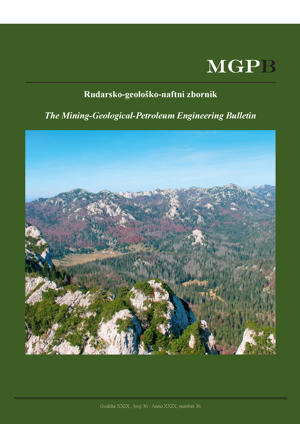Depleted hydrocarbon reservoirs and CO2 injection wells –CO2 leakage assessment
DOI:
https://doi.org/10.17794/rgn.2017.2.3Abstract
Migration risk assessment of the injected CO2 is one of the fi rst and indispensable steps in determining locations for the implementation of projects for carbon dioxide permanent disposal in depleted hydrocarbon reservoirs. Within the phase of potential storage characterization and assessment, it is necessary to conduct a quantitative risk assessment, based on dynamic reservoir models that predict the behaviour of the injected CO2, which requires good knowledge of the reservoir conditions. A preliminary risk assessment proposed in this paper can be used to identify risks of CO2 leakage from the injection zone and through wells by quantifying hazard probability (likelihood) and severity, in order to establish a risk-mitigation plan and to engage prevention programs. Here, the proposed risk assessment for the injection well is based on a quantitative risk matrix. The proposed assessment for the injection zone is based on methodology used to determine a reservoir probability in exploration and development of oil and gas (Probability of Success, abbr. POS), and modifi ed by taking into account hazards that may lead to CO2 leakage through the cap rock in the atmosphere or groundwater. Such an assessment can eliminate locations that do not meet the basic criteria in regard to short-term and long-term safety and the integrity of the site.
Downloads
Published
How to Cite
Issue
Section
License
Copyright (c) 2017 Rudarsko-geološko-naftni zbornik

This work is licensed under a Creative Commons Attribution 4.0 International License.
Creative Commons-BY
Authors who publish with this journal agree to the following terms:
In agreeing this form, you certify that:
- You read the ethical codex of the RGN zbornik available at journal web.
- You submitted work is your original work, and has not previously been published and does not include any form of plagiarism.
- You own copyright in the submitted work, and are therefore permitted to assign the licence to publish to RGN zbornik.
- Your submitted work contains no violation of any existing copyright or other third party right or any material of an obscene, libellous or otherwise unlawful nature.
- You have obtained permission for and acknowledged the source of any illustrations, diagrams or other material included in the work of which you are not the copyright owner.
- You have taken due care to ensure the accuracy of the work, and that, to the best of your knowledge, there are no false statements made within it.
- All co-authors of this submitted work are aware of, and in agreement with, the terms of this licence and that the submitted manuscript has been approved by these authors.
Publication licence
You retain copyright in your submitted work, according to journal license policy (CC-BY). By signing this form you agree that RGN zbornik may publish it under the publication licence. In summary the licence allows the following:
Anyone is free:
- To copy, distribute, display, and perform the work.
- To make derivative works.
Under the following conditions:
- The original author must always be given credit.
- The work may not be used for commercial purposes.
- If the work is altered, transformed, or built upon, the resulting work may only be distributed under a licence identical to this one.
Exceptions to the licence
In addition to publishing the work printed under the above licence, RGN zbornik will also enable the work to be visible online.
The journal editorial can change the licence rules anytime but it cannot retroactively restrict author(s) rights.


